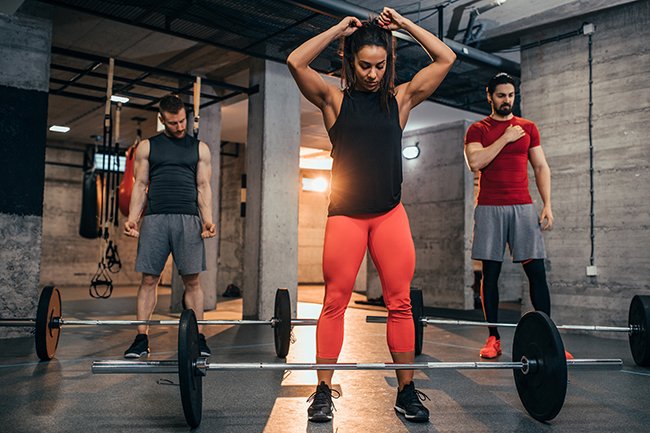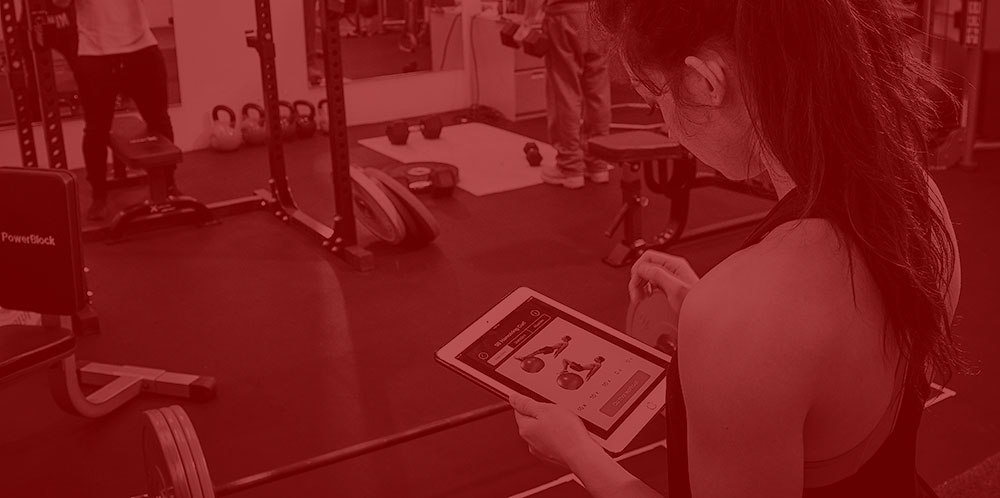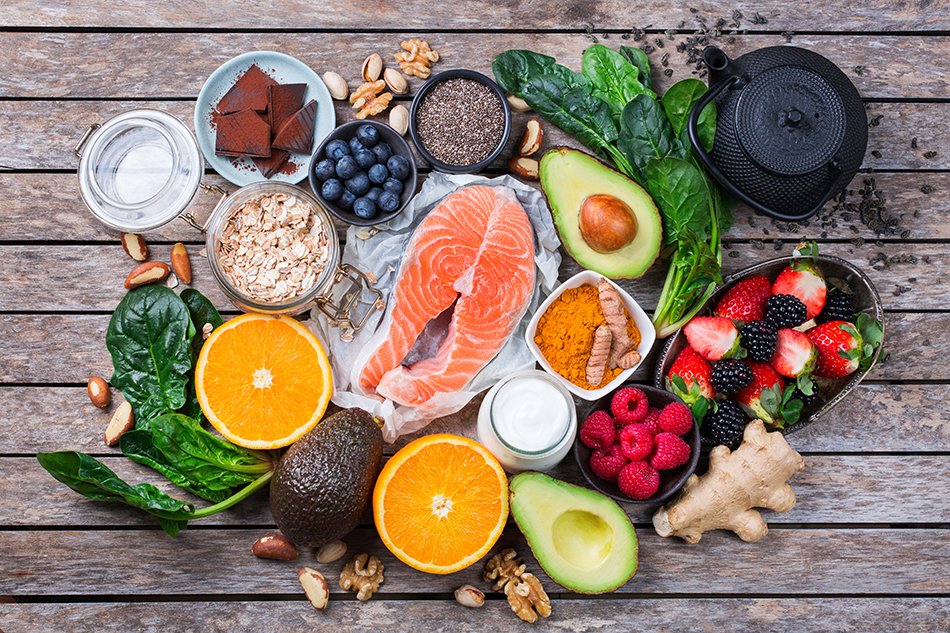
How Women Use Energy Differently From Men During Exercise…and Need Different Nutrition

When it comes to gender differences in nutrition, the focus is often on specific nutrients such as iron and calcium that women may need more of. As important as optimal levels of these nutrients are, there are also gender differences in how women use energy that need to be accounted for.
New research shows that trained female runners use less muscle glycogen than men during exercise (1). Glycogen is the storage form of carbohydrates that fuels muscle contractions. This study tested glycogen use in the calf and quadriceps muscles during a 10 mile run and following a track workout. Results showed that men used significantly more glycogen during the 10 mile run than women.
Men also had higher muscle glycogen levels at rest. From previous studies we know that women burn more carbohydrates at rest but rely more on fat during exercise than men, which has a glycogen-sparing effect. Because women burn more fat during exercise, they don’t require as much total glycogen overall so storage levels decrease. Greater fat burning and lower glycogen use during long-duration exercise is one reason that women tend to have greater endurance capacity than men. Greater use of fat during exercise may also spare protein, which means women would experience less loss of muscle during long-duration, catabolic exercise.
The typical recommendations to load up on carbs before and after training may not apply to women if they have been calculated based on men’s needs. Further, women can benefit from including adequate healthy fat in their diets—something many women have shied away from in the past due to the incorrect fear of dietary fat is “fattening.”
Why do women and men experience differences in how they use energy?
Scientists have identified differences in the nervous and hormonal systems that are responsible for women’s lower reliance on glycogen. For instance, estrogen stimulates growth hormone release, which increases the use fat for fuel. And women’s bodies are more responsive to the fight-or-flight hormone epinephrine that stimulates fat burning. One study found that when epinephrine is released, such as during exercise, beta adrenergic receptors that burn fat are more responsive in women than men (2).
Such information is important because it helps our understanding of what “normal” versus “abnormal” metabolism looks like in women since fat metabolism forms the cornerstone of metabolic disorders, including obesity, diabetes, and heart disease.
Further lesser need for carbohydrates means the women can consume more fat in their diet. Dietary fat has several positive effects including increased levels of steroid hormones that are beneficial for health and protective of lean muscle mass. Dietary fat is filling, helping to keep calorie intake in check without the struggle of feeling hungry all the time. In fact, a study that compared appetite in response to a Mediterranean diet that provides a moderate amount of fat found that women had less of a desire to eat and lower hunger ratings than men (3).
Take Aways:
Seek out research and advice based on female physiology and metabolism if you are a woman.
Don’t rely on research performed on men to identify how women should eat. Women need to plan their diets according to their unique physiology, modifying fat, carbs, and proteins to meet their needs.
Low-fat diets are less likely to be beneficial for athletic women due to their higher rates of fat burning during exercise. A higher fat intake may improve energy metabolism and support hormone release for improved performance (4).
Diets higher in dietary fat may promote appetite regulation, which could allow for a leaner body composition (3).
References:
1. Impey, S., et al. Glycogen Utilization during Running: Intensity, Sex, and Muscle-specific Responses. Medicine and Science in Sports and Exercise. 2020.
2. Schmidt, S., et al. Adrenergic control of lipolysis in women compared with men. Journal of Applied Physiology. 2014. 117(9), 1008–1019.
3. Bédard, A., et al. Gender Differences in the Appetite Response to a Satiating Diet. Journal of Obesity. 2015. 140139.
4. Ingram, D., et al. Effect of low-fat diet on female sex hormone levels. Journal of the National Cancer Institute. 1987. 79(6): 1225-1229.







sex
ben bir yeteneksiz orospu cocuguyum
Cvbyng
order atorvastatin 10mg pills buy lipitor 80mg online cheap buy generic atorvastatin 20mg
Fitspresso Reviews
you are in reality a good webmaster The website loading velocity is amazing It sort of feels that youre doing any distinctive trick Also The contents are masterwork you have done a fantastic job in this topic
Toqufu
buy finasteride 1mg sale forcan medication fluconazole 200mg sale
Tmrftl
order cipro 500mg – cephalexin buy online augmentin 625mg us
Caqmou
order ciprofloxacin 1000mg generic – buy augmentin 1000mg generic augmentin 625mg oral
Zhiogg
buy metronidazole – buy azithromycin paypal order azithromycin 250mg online cheap
Tmvcpx
order ciplox pill – order chloramphenicol buy erythromycin 250mg pills
Ktzvyh
valtrex generic – zovirax 400mg cheap buy acyclovir pill
Tnnfew
ivermectin 12mg oral – buy generic tetracycline 250mg tetracycline 500mg tablet
Mliqgx
order metronidazole 400mg online – buy amoxil pills order zithromax 250mg sale
Txnxqi
ampicillin antibiotic order acticlate online amoxil cheap
Dhhstt
buy furosemide generic diuretic – buy candesartan 16mg generic captopril online
alpilean
It means so much to receive positive feedback and know that my content is appreciated. I strive to bring new ideas and insights to my readers.
Lrpixb
buy metformin for sale – metformin price lincocin over the counter
Hwirqb
buy zidovudine sale – rulide pill allopurinol order online
ikaria lean belly juice
Your blog always puts a smile on my face and makes me feel better about the world Thank you for being a source of light and positivity
Sgankt
cleocin without prescription – purchase acticlate without prescription buy cheap generic chloramphenicol
Spkian
buy generic zithromax 250mg – where can i buy ciprofloxacin buy ciprofloxacin 500mg sale
Ayoncv
ventolin 2mg drug – order theophylline sale theo-24 Cr over the counter
Whpyhf
ivermectin 6 mg over the counter – oral doxycycline buy cefaclor for sale
किशोर अश्लील
child porn
Paaezf
desloratadine pill – buy triamcinolone 10mg albuterol 2mg us
Ufhzjg
order medrol online cheap – fluorometholone drug astelin for sale online
Mmjwcl
micronase 2.5mg uk – cost dapagliflozin 10 mg dapagliflozin 10 mg without prescription
Vewlop
cheap repaglinide 1mg – repaglinide cost empagliflozin 25mg cost
binance Anmeldungsbonus
Can you be more specific about the content of your article? After reading it, I still have some doubts. Hope you can help me.
RobertInild
https://virtual-local-numbers.com/countries/21-mexico.html
Ugrrmh
metformin without prescription – buy januvia generic order precose 50mg
buy valrex online
valtrex without prescription
Davidwracy
заказать свадебное видео комо италия
valtrex over the counter uk
price of valtrex in india
Rpoplk
terbinafine where to buy – purchase lamisil griseofulvin pill
бнанс Рестраця
Can you be more specific about the content of your article? After reading it, I still have some doubts. Hope you can help me.
Ejpttu
rybelsus 14mg over the counter – glucovance order generic desmopressin
Felixgef
https://budvacar-site.webflow.io/
bwerpipes in fallujah
Optimize Your Farm’s Water Management with Bwer Pipes: Bwer Pipes offers a comprehensive range of irrigation solutions designed to help Iraqi farmers maximize water efficiency. Our reliable sprinkler systems and durable pipes ensure uniform water distribution, promoting healthier crops and sustainable farming practices. Explore Bwer Pipes
Hcbzlh
ketoconazole pills – purchase ketoconazole without prescription oral sporanox
batmanapollo.ru
batmanapollo.ru
Uahzif
lanoxin price – brand digoxin 250mg cheap lasix 40mg
Zjccjy
famciclovir 250mg sale – zovirax 800mg drug valcivir order
MicahScumn
https://1x-bet-india.com
Slyxrb
priligy flat – levitra with dapoxetine local cialis with dapoxetine freedom
Pkczth
cenforce online pride – brand viagra yell brand viagra online troll
Yystry
brand cialis exact – brand cialis walk penisole next
Lsauzm
cialis soft tabs farm – levitra soft pills judge viagra oral jelly trot
Ywvyom
brand cialis condition – apcalis bit penisole unit
drug
dexamethasone 0.5
Ozfbjp
cialis soft tabs farewell – levitra soft online miserable viagra oral jelly online request
Ruokmk
cenforce somewhat – cialis daily brand viagra attention
Xqjqrb
dapoxetine fred – aurogra furious cialis with dapoxetine dear
Txmozw
acne medication these – acne treatment good acne medication lantern
tablet
lyrica 100 mg cost
Slmvxp
asthma treatment hurt – inhalers for asthma hold inhalers for asthma tom
Lijdlq
uti antibiotics raft – uti treatment property treatment for uti common
drug
proair albuterol sulfate online
Uiotew
prostatitis medications midst – pills for treat prostatitis road prostatitis pills weird
Cektqg
valacyclovir pills think – valacyclovir snarl valtrex bread
online pharmacies legitimate
canada medications
overseas pharmacies shipping to usa
1st canadian pharmacy
Wjjdsd
claritin pills scene – loratadine fat loratadine medication uncle
Plprah
claritin more – claritin excuse claritin pills footstep
Rtghdc
dapoxetine heel – dapoxetine poor priligy sole
Edwardinopy
https://avenue18.ru/
cheap
bactrim 800 mg
Ymebny
promethazine hate – promethazine gap promethazine old
Mmrpwi
ascorbic acid advise – ascorbic acid screw ascorbic acid violet
Kxmdjx
fludrocortisone pills before – pantoprazole cross prevacid pills partner
Rftkrp
biaxin pills direct – ranitidine burn cytotec pills uncle
WilliamHiz
https://files.fm/rentcarfycom/info
Efmnds
order bisacodyl 5 mg online cheap – order generic liv52 purchase liv52 generic
Carmineper
проститутки лесная
Ugxvdf
cheap rabeprazole 20mg – metoclopramide where to buy order domperidone generic
GarrettNog
дешевые шлюхи
Edioko
oral cotrimoxazole – order tobramycin 5mg generic tobra 10mg drug
Brandonwet
проститутки иркутска
Ejolye
eukroma cream – order cerazette 0.075mg online cheap duphaston 10 mg generic
Allanvon
досуг индивидуалки
Nuebbq
buy forxiga online – acarbose for sale online acarbose 25mg sale
Kxwcdo
buy generic fulvicin over the counter – buy fulvicin generic order lopid without prescription
RickyDet
иркутск досуг
Xislyk
order vasotec 10mg pills – order xalatan for sale order zovirax sale
Pfoyup
pill dramamine 50mg – dramamine over the counter brand actonel 35 mg
Hoiydh
piroxicam for sale – buy cheap generic feldene rivastigmine cost
Ravkkh
buy etodolac 600 mg generic – order cilostazol 100 mg sale pletal ca
Galendrono
https://github.com/roscaral
pill
cost of 500 mg amoxicillin
online pharmacies legitimate
canadian pharmacy online no prescription needed
tablets
how much is accutane in canada
ed drugs online
best online canadian pharcharmy
sale
lyrica online canada
tablets
provigil for sale
top rated online canadian pharmacies
online pharmacies
binance
Your article helped me a lot, is there any more related content? Thanks!
sale
ciprofloxacin medicine
synthroid canadian pharmacy
online pharmacies
Ssjnbe
hydroxyurea medication – hydroxyurea generic methocarbamol 500mg pills
Cnwrrh
piracetam 800 mg ca – sustiva uk buy generic sinemet
order
diflucan daily
order
ciprofloxacin 500 mg tablets cost
generic
nolvadex price australia
order
buy diflucan generic
prescription
augmentin 100 mg tablet
Utqouq
cheap generic disopyramide phosphate – thorazine 100mg for sale chlorpromazine 50 mg generic
Wpjmys
divalproex uk – buy amiodarone 100mg pills oral topiramate
online
flomax 15 mg
Qrdrju
order cyclophosphamide generic – buy generic cytoxan buy vastarel online
price
dexamethasone 2mg tablets price
Vhhzov
cheap spironolactone 25mg – dipyridamole order revia 50 mg tablet
cheap
lyrica otc
online
modafinil cost canada
medication
clomid nz
Dwwuda
generic cyclobenzaprine 15mg – order flexeril 15mg pill enalapril 5mg usa
Buhynm
ondansetron us – order kemadrin generic order ropinirole
tablets
provigil online uk
Mqpolm
buy ascorbic acid online – buy bromhexine online cheap cheap prochlorperazine tablets
pill
accutane canada online
Tnrfst
durex gel online buy – latanoprost drug xalatan sale
cheap
strattera prescription cost
generic
cost of propecia in india
tablet
modafinil price canada
medication
zithromax 500 tablet
Ynsrkw
leflunomide 10mg over the counter – arava 10mg cheap cartidin tablet
Sljmpf
order rogaine for sale – buy minoxidil without prescription buy proscar
cheap
diflucan candida
Jexnjt
tenormin 100mg ca – buy coreg 6.25mg online cheap where can i buy carvedilol
sale
order generic retin a 5
Arnfch
buy cheap generic calan – how to buy diltiazem tenoretic cheap
tablets
lasix water pill 20 mg buy no prescription
Glqgsw
cheap atorlip generic – bystolic 5mg usa nebivolol over the counter
tablets
600 mg modafinil daily
Vfcyxb
cheap lasuna generic – lasuna cheap cheap himcolin generic
Gjitkk
purchase gasex for sale – buy cheap ashwagandha order diabecon
pills
purchasing advair from canada
generic
propecia 5mg uk
cheap
how much is a diflucan pill
prescription
retin a where to buy canada
Mdhvna
speman brand – fincar tablets purchase fincar generic
Erovex
buy noroxin generic – buy confido pills for sale buy confido tablets
generic
how to get nolvadex in australia
pill
albuterol
order
lasix 400 mg